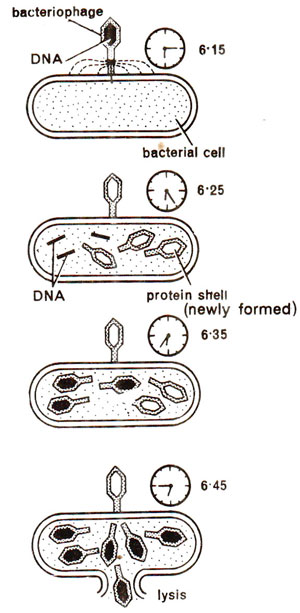Genetics / Sexuality and Recombination in Bacteria and Viruses
Replication of bacteriophages
A typical bacteriophage (abbreviated as 'phage' meaning 'eaters of bacteria') consists of a head with protein sheath containing DNA and a tail with tail fibres (Fig. 12.17). A bacterium that has been infected by phage will undergo lysis (breaks open) within about 30 minutes and will release about 100 phage particles complete in all respects (Fig. 12.18). After infection, phage DNA forces the host to work for the parasite, so that complete host machinery is utilized for replication of phage particle. The infected cell thus creates new protein subunits for the phage head and tail and also makes additional DNA segments identical to DNA of the invading phage particle. In other words we can say that the phage orders the host's genetic material to stop functioning and establishes itself in power, controlling entire cell's protein metabolism. We can also describe the phage growth as a molecular cancer, since it keeps on multiplying till the host cell undergoes lysis.

Fig. 12.17. T4 bacteriophage and its components : (a) on top lel't-a complex phage particle is shown; (b) on bottom left-a phage particle attached to bacterial cell wall is shown; (c) on the right-various components, are shown.

Fig. 12.18. Different stages of infection, multiplication and lysis of virus particles in a bacterial cell; the clock shows the time taken for different steps of reproduction of virus
Support our developers

More in this section